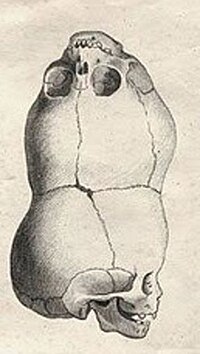
Photo from wikipedia
Mesenchymal stromal cell (MSC) transplantation is a promising treatment to promote myocardial repair. Among various sources, the amnion has an advantage in mass production of high-quality MSCs due to its… Click to show full abstract
Mesenchymal stromal cell (MSC) transplantation is a promising treatment to promote myocardial repair. Among various sources, the amnion has an advantage in mass production of high-quality MSCs due to its large initial cell-yield and prenatal nature of isolated cells. In addition to the powerful tissue-repair potential, amnion-derived MSCs (AMSCs) exhibit a robust immunomodulative ability, enabling allogeneic transplantation without immunosuppressive reagents. We here report a novel bioengineering technique to deliver AMSCs for myocardial repair by epicardial placement of self-adhesive, bi-layered, AMSC-incorporating dressings (AMSC-dressing), which is fabricable on-site (Figure A). AMSC-dressing was fabricated by spreading AMSC suspension on the inner layer of a fibrin sealant film, composed of fibrinogen and thrombin. Due to the resulting adhesive AMSC-fibrin complex, the AMSC-dressing firmly adhered to the heart surface without the need for suture or additional glue. The outer collagen layer of the film facilitated the easy handling and also protected the AMSC-fibrin complex from external damage. We applied a 1 cm2 dressing containing 0, 1, 2 or 4 millions of rat AMSCs to a rat ischemic cardiomyopathy model (4 weeks post coronary artery ligation). Intramyocardial (IM) injection of 4 millions of AMSCs and sham treatment were also conducted. Echocardiography and catheterization consistently demonstrated that AMSC-dressing therapy improved cardiac function and reduced heart dilatation in a dose-dependent manner compared to the sham control. Furthermore, this therapeutic effect exceeded that of IM injection (Figure B). Histological analyses revealed that AMSC-dressing therapy resulted in augmented myocardial tissue repair (increased neovascularization, attenuated pathological fibrosis and reduced cardiomyocyte hypertrophy) compared to IM injection and sham groups. These effects were associated with increased upregulation of a range of tissue repair-related genes including Il10, Cxcl12, Igf1, Timp1, Hif1a, Tgfb, Mmp2, Hgf, Fgf2 and Vegf. Of note, it was elucidated that both initial retention and subsequent survival of donor AMSCs were enhanced by the dressing technique compared to IM injection. In addition, in vitro studies demonstrated that culturing in a fibrin glue not only enhanced upregulation of tissue-repair genes of AMSCs but also improved their survival against environmental stress through activating the Akt/PI3K cell-survival pathway. AMSC-dressing therapy enhanced both quantity and quality of donor cell engraftment, leading to the augmented therapeutic efficacy, compared to the current method. Furthermore, this technique is user-friendly and requires no specialized equipment at the treating hospital, highlighting its great potential to be a widely-adopted, standard treatment for heart failure. Further development of this advanced cell therapy towards clinical application is justified. British Heart Foundation, Heart Research UK, Japan Agency for Medical Research and Development, Kaneka Corporation
Journal Title: European Heart Journal
Year Published: 2019
Link to full text (if available)
Share on Social Media: Sign Up to like & get
recommendations!